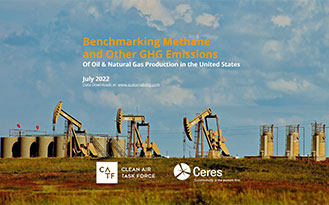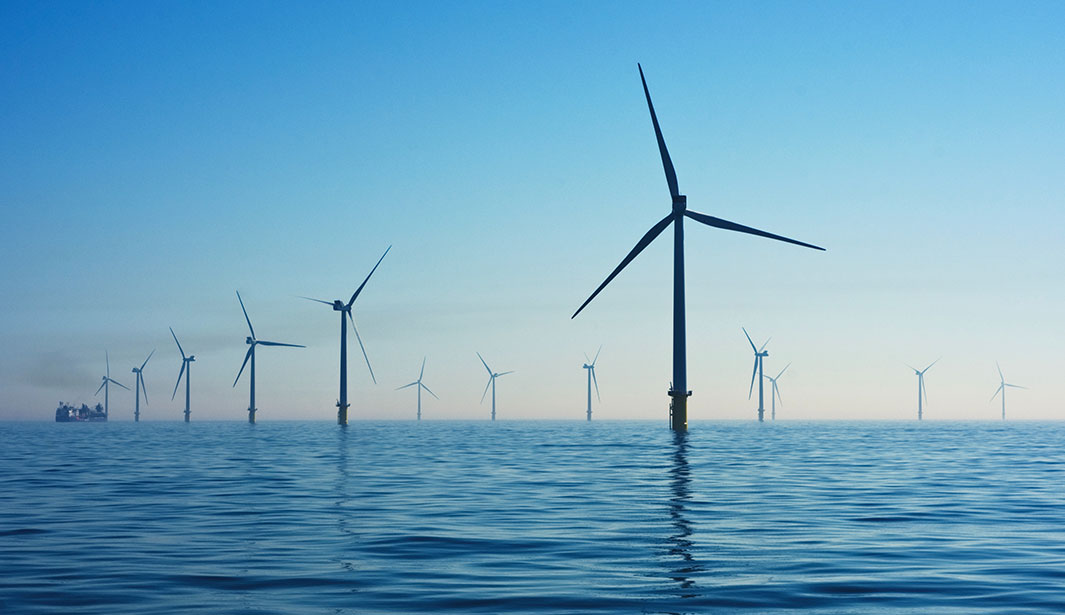
Carbon dioxide emissions from the U.S. power sector increased by 7% in 2021 over the previous year, as economies around the world reopened following shutdowns related to the coronavirus pandemic, according to a new benchmark analysis of air emissions of the nation’s 100 largest power producers. In 2020, the industry’s CO2 emissions had dropped a record 10%, its largest one-year decrease in emissions over the report’s 18 editions.
The 2021 increase disrupted a steady downward trend for all power sector air emissions. It also highlights the need for power providers to take advantage of the clean energy incentives in the recently passed Inflation Reduction Act, and rapidly transition to cleaner resources, particularly given the critical near-term role the power sector must play as the nation works to cut its total emissions in half by 2030.
The report, Benchmarking Air Emissions of the 100 Largest Electric Power Producers in the United States, found that overall, carbon dioxide emissions from U.S. power generation were still about 34% lower in 2021 than their 2007 peak. Since 2000, sulfur dioxide and nitrogen oxides emissions have decreased 93% and 85%, respectively. Overall, zero-carbon generation, which includes renewables, hydro, and nuclear power, is on the rise, hitting an all-time high in 2021 of 40% of all U.S. power.
“While the power sector has shown marked improvement over our two decades of analysis, we need to see an acceleration of larger emissions cuts across the industry in order to reach our 2030 emissions reduction goals,” said Dan Bakal, senior program director of climate and energy at Ceres. “It’s important to recognize how far we have come, but impossible to ignore how far we still have to go to meet our critical 2030 goals set by the Paris Accord. While many of the largest power producers have announced climate commitments and strategies to reduce their carbon emissions, the rapid decarbonization required demands increased ambition.”
The recent increase in carbon dioxide emissions was also driven by a rise in coal generation and a decrease in natural gas generation, the report shows, as U.S. natural gas prices increased. While renewable generation ticked up one percentage point between 2020 and 2021, that increase represented a fraction of the 3% to 4% annual increase estimated as necessary to meet global climate goals.
In coming years, renewable energy and other zero-carbon generation sources will be incentivized in the U.S. as the Inflation Reduction Act provides tax credits for wind, solar, and other carbon-free power sources and billions in targeted grant and loan programs to accelerate the transition to clean electricity. Through incentives for the existing fleet, the legislation also recognizes the contributions of nuclear power plants to the nation’s carbon free electricity supply. Electric power is expected to account for a growing share of energy consumption in the U.S. as the transportation sector and other end uses electrify, making a clean power grid a critical part of the pathway to the net zero economy.
“While heat-trapping carbon emissions rebounded in the power sector last year, compared to 2020 levels in the depths of the pandemic, it's important to note that clean electricity continued forging ahead, reaching all-time highs,” said Amanda Levin, director of policy analysis in the science office at the Natural Resources Defense Council (NRDC). “To meet our nation’s climate goals, we must accelerate this ongoing shift to clean energy. The enactment of the Inflation Reduction Act, with its substantial clean energy investments, will help galvanize that move, resulting in bending power sector emissions back down and significantly cutting carbon pollution this decade.”
The annual analysis benchmarks key air pollutant emissions, including nitrogen oxide, sulfur dioxide, carbon dioxide, and mercury, from the 100 largest U.S. power producers. It relies upon publicly reported generation and emissions data from the U.S. Energy Information Administration and the U.S. Environmental Protection Agency and provides a useful record of the sector’s environmental performance. It consistently shows a decoupling of emissions and GDP, demonstrating that economic growth and emissions reductions can go hand in hand.
“The electric industry has a long-standing tradition of using technology to solve our nation’s toughest energy challenges, and now we must apply that same spirit of innovation to address the incredible human toll of the climate crisis,” said Joe Dominguez, president and CEO of Constellation, the nation’s largest producer of carbon-free energy. “Building on the foundation of our always-on nuclear fleet, Constellation has committed to produce 100 percent of its electricity from clean, emissions-free resources by 2040, while continuing to invest in solutions that decarbonize our economy and help our customers meet their sustainability goals.”
“This increase in power sector emissions comes at a time when the Inflation Reduction Act has put the 2030 US climate goals back in reach,” said Robert LaCount, ERM’s Climate Change lead for North America. “It marks a critical moment for the power sector, as new clean energy incentives reshape the investment landscape and provide an opportunity for companies to significantly accelerate their decarbonization journeys.”
Relying upon the most recent available data, the report includes extensive analysis of company-level emissions and production data from 2020 as well as evaluation of sector-wide trends for 2021. The 100 largest power producers in the United States collectively accounted for more than 80% of the sector’s total generation and reported air emissions across nearly 3,500 owned power plants, while fuel mix, emissions, and emission rates vary widely between companies. Air emissions from power plants are highly concentrated among a small number of producers. For example, nearly a quarter of the electric power industry’s sulfur dioxide and carbon dioxide emissions are emitted by just the top two and top five power producers nationally, respectively.
“The electric utility industry has made important progress over many years delivering increasingly clean energy to our customers,” said John Weiss, Entergy’s vice president of sustainability and environmental policy. “But there’s more we can and must do, which is why Entergy is accelerating our transition to the lower-carbon and more climate resilient future that our customers and communities demand. This annual benchmark continues to help hold us, and the entire industry, accountable for delivering those results.”
Other key findings from the report include:
- Power plant mercury air emissions, as reported to the EPA’s Toxic Release Inventory database, have decreased 93% since 2000. The first-ever federal limits on mercury and other hazardous air pollutants from coal-fired power plants went into effect in 2015.
- 90 of the top 100 power producers generated power from zero-carbon resources in 2020.
- Despite a year-over-year decline, for the sixth consecutive year, in 2021 natural gas was the leading source of electricity generation in the U.S. (38%), followed by coal (22%) which experienced a 16% jump in generation from 2020 to 2021.
- Non-hydro renewables made up 13% of total U.S. generation in 2020. Of that, 29% came from solar, 68% from wind, and 3% from geothermal sources.
The benchmarking analysis is a collaborative effort between Ceres; Bank of America Charitable Foundation; power producers Constellation Energy and Entergy; and the Natural Resources Defense Council (NRDC). It is authored by ERM. Read the full report
About Ceres:
Ceres is a nonprofit organization working with the most influential capital market leaders to solve the world’s greatest sustainability challenges. Through our powerful networks and global collaborations of investors, companies and nonprofits, we drive action and inspire equitable market-based and policy solutions throughout the economy to build a just and sustainable future. For more information, visit ceres.org and follow @CeresNews.
About Constellation
Constellation Energy Corporation (Nasdaq: CEG) is the nation’s largest producer of clean, carbon-free energy and a leading supplier of energy products and services to millions of homes, institutional customers, the public sector, community aggregations and businesses, including three fourths of Fortune 100 companies. A Fortune 200 company headquartered in Baltimore, our fleet of nuclear, hydro, wind and solar facilities has the generating capacity to power approximately 20 million homes, providing 10 percent of all carbon-free energy on the grid in the U.S. Our fleet is helping to accelerate the nation’s transition to clean energy with more than 32,400 megawatts of capacity and annual output that is nearly 90 percent carbon-free. We have set a goal to achieve 100 percent carbon-free power generation by 2040 by leveraging innovative technology and enhancing our diverse mix of hydro, wind and solar resources paired with the nation’s largest nuclear fleet. Follow Constellation on Twitter @ConstellationEG.
About Entergy
Entergy (NYSE: ETR), a Fortune 500 company headquartered in New Orleans, powers life for 3 million customers through its operating companies across Arkansas, Louisiana, Mississippi and Texas. Entergy is creating a cleaner, more resilient energy future for everyone with our diverse power generation portfolio, including increasingly carbon-free energy sources. With roots in the Gulf South region for more than a century, Entergy is a recognized leader in corporate citizenship, delivering more than $100 million in economic benefits to local communities through philanthropy and advocacy efforts annually over the last several years. Our approximately 12,000 employees are dedicated to powering life today and for future generations. Learn more at entergy.com and follow @Entergy on social media.
About ERM
ERM is the business of sustainability. As the largest global pure-play sustainability consultancy, ERM partners with the world’s leading organizations, creating innovative solutions to sustainability challenges and unlocking commercial opportunities that meet the needs of today while preserving opportunities for future generations. ERM’s diverse team of 7,000+ world-class experts in over 170 offices across 39 countries supports clients across the breadth of their organizations to operationalize sustainability. Through ERM’s deep technical expertise, clients are well-positioned to address their environmental, health, safety, risk, and social issues. ERM calls this capability its “boots to boardroom” approach - a comprehensive service model that allows ERM to develop strategic and technical solutions that advance objectives on the ground or at the executive level.
About NRDC
NRDC (Natural Resources Defense Council) is an international nonprofit environmental organization with more than 3 million members and online activists. Since 1970, our lawyers, scientists, and other environmental specialists have worked to protect the world's natural resources, public health, and the environment. NRDC has offices in New York City, Washington, D.C., Los Angeles, San Francisco, Chicago, Bozeman, MT, and Beijing. Visit us at www.nrdc.org and follow us on Twitter @NRDC.
About Bank of America Charitable Foundation
At Bank of America, we’re guided by a common purpose to help make financial lives better, through the power of every connection. We’re delivering on this through responsible growth with a focus on our environmental, social and governance (ESG) leadership. ESG is embedded across our eight lines of business and reflects how we help fuel the global economy, build trust and credibility, and represent a company that people want to work for, invest in and do business with. It’s demonstrated in the inclusive and supportive workplace we create for our employees, the responsible products and services we offer our clients, and the impact we make around the world in helping local economies thrive. An important part of this work is forming strong partnerships with nonprofits and advocacy groups, such as community, consumer and environmental organizations, to bring together our collective networks and expertise to achieve greater impact. Learn more at www.bankofamerica.com/environment.
 View all
View all 



